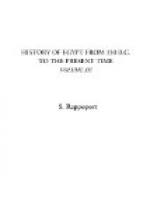The capitulations or agreements concerning justice entered into by all the Great Powers of Europe and the Ottoman Empire, relative to the trial and judgment of Europeans, include Egypt as an integral part of the Turkish Empire. Foreigners for this reason have the privilege of being tried by European courts. But if one party in a case is European and another Egyptian, there are special mixed tribunals, established in 1876, consisting partly of native and partly of foreign judges. These tribunals settle civil and also some criminal cases between Egyptians and Europeans, and in 1900 penal jurisdiction was conferred upon them in connection with offences against the bankruptcy laws.
There are three mixed tribunals of the first class, with a court of appeal, sitting at Alexandria. Civil cases between foreigners of the same nationality are tried before their own consular courts, which also try criminal cases not within the jurisdiction of the mixed tribunals, in which the accused are foreigners. By this well organised administration of justice, crime has steadily decreased throughout Egypt, and the people have learned to enjoy the benefit of receiving impartial justice, from which they had been shut off for many centuries.
About sixty per cent, of the inhabitants of modern Egypt belong to the agricultural class—the fellaheen. The peasantry are primitive and thrifty in their habits, and hold tenaciously to their ancient traditions. They are a healthy race, good-tempered and tractable, and fairly intelligent, but, like all Southern nations breathing a balmy atmosphere, they are unprogressive. Centuries of oppression have not, however, crushed their cheerfulness. There is none of that abject misery of poverty among the Egyptians which is to be seen in cold countries. There is no starvation amongst them. Food is cheap, and a peasant can live well on a piastre (five cents) a day. A single cotton garment is enough for clothing, and the merest hut affords sufficient protection. The wants of the Egyptians are few. Their condition, now freed from forced labour, called the “Courbash,” as also from injustice, crushing taxation, and usury, which characterised former administrations, compares favourably with the peasantry of many countries in Europe, and is equal, if not superior, to that of the peasantry of England itself.
Under the British protection there has been a renewal of the Koptic Christian race. They are easily to be distinguished from their Muhammedan countrymen, being lighter in colour, and resembling the portraits on the ancient monuments. They are a strong community in Upper Egypt, whither they fled from the Arab invaders, and they there hold a large portion of the land. They live mostly in the towns, are better educated than other Egyptians, and are employed frequently in the government service as clerks and accountants.
Koptic is still studied for church purposes by the Kopts, who both by their physiognomy and by their retention of the old Egyptian institution of monasticism are the only true descendants having the social and physical heredity of the ancient Egyptians. Four of the oldest monasteries in the world still survive in the Natron Valley.




